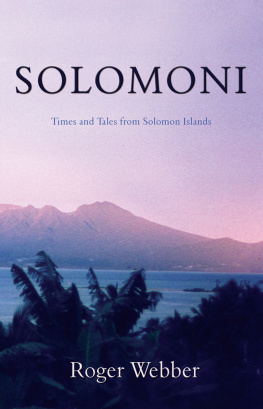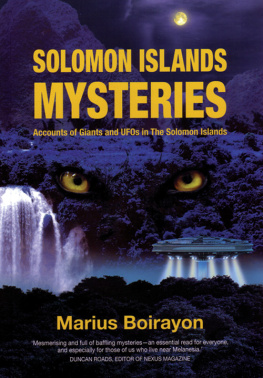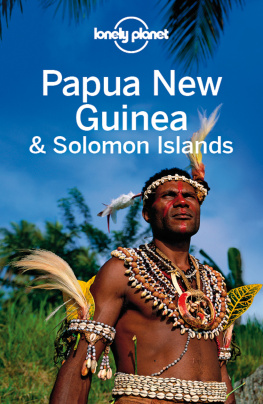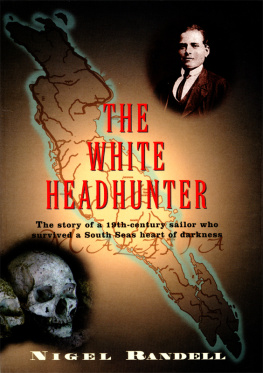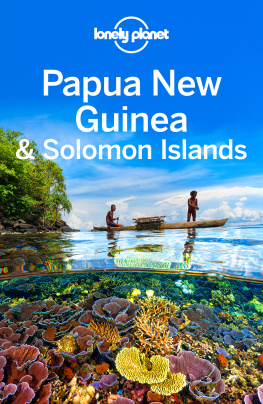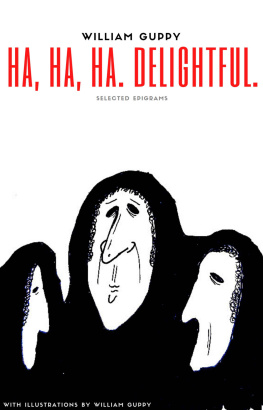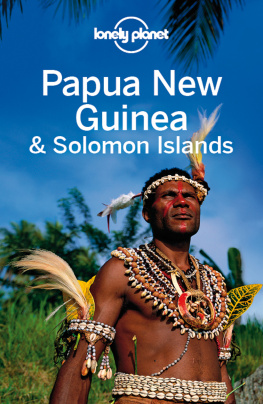| Note: | Images of the original pages are available through Internet Archive. See https://archive.org/details/cu31924028691149 |
Please see at the end of this text.
THE SOLOMON ISLANDS
Map of Solomon Islands
London: Swan Sonnenschein & Co.
(1500 x 990 px., 421 kB)
THE
SOLOMON ISLANDS
AND
Their Natives.
BY
H. B. GUPPY, M.B., F.G.S.
LATE SURGEON, R.N.
Publisher's logo
LONDON:
SWAN SONNENSCHEIN, LOWREY & CO.,
PATERNOSTER SQUARE,
1887.
S. Cowan & Co. Strathmore Printing Works, Perth.
PREFACE.
W hen , in the beginning of 1881, H.M.S. Lark was being prepared for her commission as a surveying ship in the Western Pacific, I was selected by Sir John Watt Reid, the Medical Director-General of the Navy, to be appointed as Surgeon. For this selection I was also in some measure indebted to the late Sir Frederick Evans, then Hydrographer, who was desirous that a person possessing tastes for natural history should be chosen. I subsequently received some instructions from Dr. Gnther, Keeper of Zoology in the British Museum, to whom I may take this opportunity of expressing my sincere thanks for the encouragement he gave to me during the commission. Unfortunately there were no public funds from which I could be assisted; and, as a matter of fact, I may state that all expenses had to come out of my pay as a naval surgeon. At the close of the commission I received, mainly through the influence of Dr. Gnther, a promise of a grant of 150 from the Royal Society of London for the exploration of the interior of the large island of Guadalcanar; but a very serious illness prevented me from carrying out my intention, and thus an expedition, which I had looked forward to as a fitting completion of my work in these islands, was never undertaken. However, my disappointment was in some measure diminished on my arrival in England, after being invalided, by the important results arising from the examination by Dr. John Murray, Director of the Challenger Commission, of that portion of my geological collection which threw light on the formation of coral reefs, and which exhibited the deep-sea deposits of the Challenger Expedition as rocks composing islands in the Solomon Group. To Dr. Murray I am indebted for much kindness in many ways, and I gladly take this opportunity of expressing my sincerest thanks.
In this volume I have chiefly confined myself to my observations on the anthropology, natural history, botany, and meteorology of the group, having originally reserved my account of the geology and of the coral reefs, together with my special descriptions of the islands, for another volume, which I hoped to publish shortly, if my first undertaking proved a success. My reasons for thus acting were to be found in a lack of funds and in the necessity of not overlading my first venture, which, like a ship carrying a heavy though perhaps a valuable cargo, might founder within sight of the port of departure. This difficulty has been met by a generous arrangement of my publishers, in consequence of which both volumes will be brought out together. All my notes relating to these islands are there embodied, with the exception of my coral reef observations, which have been recently published by the Royal Society of Edinburgh in their Proceedings (1885-1886). However, to make this volume more complete, I have added a short containing a general description of the islands.
It is necessary that I should here briefly allude to the circumstances under which my observations and collections were made. Had I been previously aware of the difficulties and discomforts that would attend me, I should have hesitated to have performed more than a tithe of what I finally accomplished per varios casus per tot discrimina rerum. Inexperienced and deprived of any official support or recognition of other than my professional duties, I was only urged on by the consciousness of the importance of the work I had voluntarily undertaken. At length my health began to give way, and it was with mixed feelings of satisfaction and apprehension that I returned to the islands for the third and last year. One cause of continual worry lay in the fact that for two-thirds of the time spent in this region, I had only my cabin for the disposal of my collections, the size of the ship (a schooner of about 150 tons), and the arrangements made before leaving England, not permitting of any other plan.
Under these circumstances I received the greatest assistance from Lieut.-Commander C. F. Oldham, who, notwithstanding that he had received no instructions concerning myself, smoothed the way for me and gave me the opportunities I desired, often, it should be added, at the expense of much anxiety to himself. To the officers, Lieut. C. F. de M. Malan, Lieut. T. H. Heming, and Lieut. A. Leeper, I am lastingly indebted, not only for their constant aid, but also for the sympathy they evinced towards myself and my pursuits. From the petty-officers and crew I received much voluntary help, and I was often indebted to the services of Mr. Samuel Redman and Mr. Albert Rowe. My right-hand man was Mr. William Isabell who had been sent to the ship as Leading-Stoker to take charge of the condenser. Without his aid in the packing away of my collections and his cheerful readiness to assist me in every way throughout the commission, I should have broken down long before I did. To his careful attendance during my illness I owe my life.
With reference to the different sections of this work, I should remark that the anthropological notes are for the most part now published for the first time. The translation of of the group. The enumeration of the many disinterested services I have received would carry me far beyond the limits of a preface. Of all of them I shall retain a lasting remembrance.
HENRY BROUGHAM GUPPY.
17 Woodlane, Falmouth.
INTRODUCTION.
T he Solomon Islands cover an area 600 miles in length. They include seven or eight large mountainous islands attaining an extreme height, as in the case of Guadalcanar and Bougainville, of from 8,000 to 10,000 feet, and possessing a length varying from 70 to 100 miles, and a breadth varying between 20 and 30 miles. In addition, there are a great number of smaller islands which range in size from those 15 to 20 miles in length to the tiny coral island only half a mile across. The islands fall naturally into two divisions, those mainly or entirely of volcanic formations and those mainly or entirely of recent calcareous formations.
In the first division, St. Christoval may be taken as a type of the large mountainous islands possessing massive profiles, such as Guadalcanar, Malaita, Isabel, etc. St. Christoval, which rises to a height of 4,100 feet above the sea, is composed in the mass of much altered and sometimes highly crystalline volcanic rocks (such as, in their order of frequency, dolerites, diabases, diorites, gabbros, serpentines, and saussuritic felspar-rock) which, as I learn from Mr. T. Davies, have been both formed and altered at considerable depths and indicate great geological age and extensive denudation. Recent calcareous rocks, such as will be subsequently referred to in the description of the second division of islands, flank the lower slopes at the sea-border up to an elevation of 500 feet. Fragments of similar diorites, dolerites, and other dense basic rocks, all much altered and often schistose, have been transported by trees to the coral islets off the coasts of Guadalcanar and afford evidence of the geological structure of that island. Serpentines were obtained by Dr. Hombron in 1838 from St. Georges Island, which is ipso facto a portion of Isabel. Bougainville and New Georgia are largely of more recent origin, as is indicated by their numerous symmetrical volcanic cones. However, the geological evidence at present at our disposal points generally to the great antiquity of the larger islands. The significance of this fact will be subsequently referred to. There can be little doubt that some of the mountainous islands will be found to yield in quantity the ores of tin and copper. A resident trader, Captain John Macdonald, has discovered arsenical pyrites and stream tin at the head of the Keibeck River in the interior of St. Christoval. A sample of stream tin from the south-east part of Bougainville was given to me by the Shortland chief. Copper will not improbably be found in association with the serpentine rocks of these islands.




